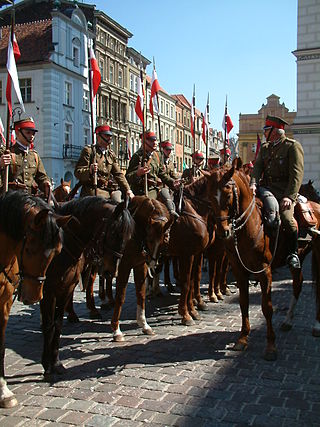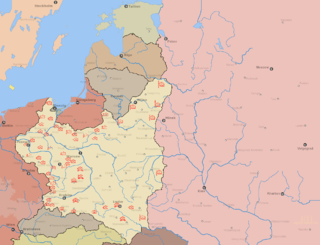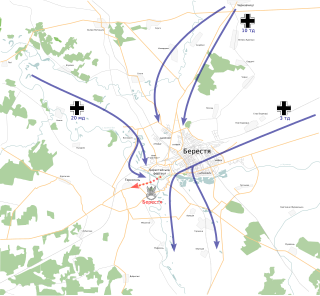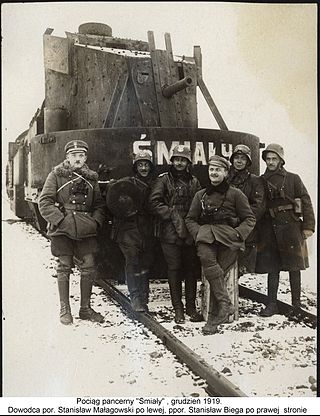This article needs additional citations for verification .(February 2024) |
The Danuta, also called Armoured Train Number 11, was a Polish armoured train used by the Polish Army during the German invasion of Poland in September 1939.
Contents

This article needs additional citations for verification .(February 2024) |
The Danuta, also called Armoured Train Number 11, was a Polish armoured train used by the Polish Army during the German invasion of Poland in September 1939.

The Danuta was built in Poznań in 1919. In August 1920, the train participated in the Battle for Warsaw, as part of the Polish 1st Army. In 1924, the Danuta was assigned to the armoured train training unit located in Jabłonna, Legionowo County. Like most other Polish armoured trains, the Danuta was modernised in the early 1930s by receiving a Ti3 type locomotive, additional guns and AA machine guns.
After the Polish Army was mobilised in 1939, the train was assigned to the Poznań Army. In the first days of the war, the Danuta supported various Polish infantry units. On 4 September, the train was bombed by the Luftwaffe , but received only minor damage. Next the train participated in the Battle of the Bzura. On 16 September, the train helped to halt the advance of the German 24 Division and tried to withdraw towards the Polish 16 Infantry Division, but was ambushed by the German anti-tank artillery. [1] The damage received in the ambush and the fact that the train's ammunition supplies were almost depleted forced the commander of the train, Captain Korobowicz, to order the train to be blown up, together with the assaulting German infantry, to prevent German capture. Out of the tanks used to scout on and off the rails, five tankettes TKS were evacuated successfully and two FT-17 tanks blown up.

An armoured fighting vehicle or armored fighting vehicle (AFV) is an armed combat vehicle protected by armour, generally combining operational mobility with offensive and defensive capabilities. AFVs can be wheeled or tracked. Examples of AFVs are tanks, armoured cars, assault guns, self-propelled artilleries, infantry fighting vehicles (IFV), and armoured personnel carriers (APC).

The Polish cavalry can trace its origins back to the days of medieval cavalry knights. Poland is mostly a country of flatlands and fields and mounted forces operate well in this environment. The knights and heavy cavalry gradually evolved into many different types of specialised mounted military formations, some of which heavily influenced western warfare and military science. This article details the evolution of Polish cavalry tactics, traditions and arms from the times of mounted knights and heavy winged hussars, through the times of light uhlans to mounted infantry equipped with ranged and mêlée weapons.

This article discusses the Polish order of battle during the invasion of Poland. In the late 1930s Polish headquarters prepared "Plan Zachód", a plan of mobilization of Polish Army in case of war with Germany. Earlier, the Poles did not regard the Germans as their main threat, priority was given to threat from the Soviets.

The siege of Warsaw in 1939 was fought between the Polish Warsaw Army garrisoned and entrenched in Warsaw and the invading German Army.

An armoured train or armored train is a railway train protected with heavy metal plating and which often includes railway wagons armed with artillery, machine guns, and autocannons. Some also had slits used to fire small arms from the inside of the train, especially in earlier armoured trains. For the most part, they were used during the late 19th and early 20th centuries, when they offered an innovative way to quickly move large amounts of firepower into a new location. Most countries discontinued their use – road vehicles became much more powerful and offered more flexibility, train tracks proved too vulnerable to sabotage and attacks from the air, and air transportation was an even more flexible way to relocate firepower to a new location. However, there were occasional uses in the late 20th century and early 21st century Russian Federation used improvised armoured trains in the Second Chechen War (1999–2009) and the Russian invasion of Ukraine (2022–present).

The Battle of Brześć Litewski was a World War II battle involving German and Polish forces that took place between 14 and 17 September 1939, near the town of Brześć Litewski. After three days of heavy fights for the stronghold in the town of Brześć, the Germans captured the fortress and the Poles withdrew.

The Battle of Kobryń was one of the battles of the Invasion of Poland. It was fought between 14 and 18 September 1939, between the German XIX Panzer Corps of General Heinz Guderian and the improvised Polish 60th Infantry Division "Kobryn" of Colonel Adam Epler. It was fought concurrently with the Battle of Brześć Litewski.

The 4th Panzer Division was an armored division in the Army of Nazi Germany.

The Battle of Mokra took place on 1 September 1939 near the village of Mokra, 5 km north of Kłobuck and 23 km north-west of Częstochowa, Poland. It was one of the first battles of the Invasion of Poland, during the Second World War, and was one of the few Polish victories of that campaign and the first German defeat of the conflict.

The Battle of Jordanów took place on 1–3 September 1939, during the Invasion of Poland and the opening stages of World War II. It was fought between the German XVIII Panzer Corps of Gen.E.Beyer and the Polish 10th Motorized Cavalry Brigade under Col. Stanisław Maczek.
Polish 3rd Legions Infantry Division was a tactical unit of the Polish Army between the World Wars. Formed in 1919, as a third unit composed significantly of veterans of the Polish Legions in World War I, it saw extensive action during the Polish-Bolshevik War and the Invasion of Poland. In the interbellum period, the headquarters of the division was stationed in Zamość, while its regiments were garrisoned in Chelm, Lublin, Zamosc and other locations.

Armoured Train Bartosz Glowacki, also called Armoured Train number 55 or PP 55 was a Polish Army armoured train, used during the Polish-Soviet War and the Polish September Campaign. On 11 September 1939, it was assigned to the Operational Group Wyszkow and was directed to the fortress of Brześć nad Bugiem, where it fought German units of the SS-Verfügungstruppe. After withdrawal southwards, to Lwów, it helped some of the Polish units cross the German lines, but needed to be recovered after the artillery and anti--tank guns of the 1st Mountain Division (Wehrmacht) heavily damaged it. The train might have been finished off by the Luftwaffe, since it was never recovered. Other sources indicate that it might've been hit by artillery and captured by the Red Army along with the Śmiały when Lwów fell.

The armoured train Śmiały, sometimes PP 53 and officially Armoured Train number 53 was an armoured train of the Polish Army that saw significant action during the German Invasion of Poland in September 1939. The train in the end served under four flags—Austrian, Polish, Soviet, German—and fought in several wars from 1914 to 1945. Śmiały distinguished itself in the Battle of Mokra, after which it withdrew eastwards, taking part in the Battle of Brześć Litewski. After the Soviet invasion of Poland on September 17, the train left the western front via Kowel to Lwów, where it fought in the Battle of Lwów. On September 22, 1939, abandoned by its crew, it was seized by the Red Army.

Piłsudczyk was a Polish armoured train of the early 20th century. It was among the first armoured trains serving the Polish Army and took part in the Polish-Ukrainian War of 1918-1919, the subsequent Polish-Soviet War and the Silesian Uprisings. Kept in reserve during the inter-war years, it was mobilised again in 1939 to be used during the Nazi-Soviet Invasion of Poland. "Piłsudczyk" was destroyed by its crew on 20 September 1939 at the train station at Mrozy.
Armored trains of Poland mostly date to the World War I period. Many of them were modernized over the next two decades, and took part in most military conflicts of the Second Polish Republic, namely the Greater Poland Uprising, the Polish-Ukrainian War, the Polish-Bolshevik War, the Silesian Uprisings and the Polish September Campaign in World War II. Armored trains were also used by the Polish Armed Forces in the West as well as in the post-war period by the Polish Railroad Guards and the People's Army of Poland.

The First Battle of Grodno took place on 19 and 20 July 1920, during the Polish-Soviet War. In the effect of a three-day-long struggle for the control of the city of Grodno, the town was captured by Russian forces, despite repeated counter-attacks by Polish infantry, tanks and armoured trains.
The armoured train Groźny also known as PP 54 and Armoured Train number 54 was an armoured train of the Polish Army that saw action during German Invasion of Poland in September 1939 and later in German service with portions of it seeing service on the Eastern Front and the occupation of France. It was originally captured about 1919–20 from the Soviet Union in the Polish-Soviet War.

The Battle of Częstochowa was one of the first battles of the Invasion of Poland during World War II. It took place on September 1–3, 1939.